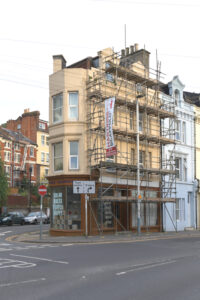In one of those directionless states of youth and looking for something different, I saw an advertisement in a local paper for a trainee scaffolder, and so I called the number. A man with a thick Kent accent answered, and a brief conversation ensued.
I’ve always felt drawn to scaffolding. I guess this is probably true of anybody who sees geometric patterns everywhere, and if you can see the world in this way, then it seems to me that you’ll find scaffolding fascinating.

Scaffolding is a feat of engineering, a work of art. It is strong and resilient. It supports the heaviest of loads, and can weather the fiercest of storms. It is a symbol of stability and endurance, but more, given it’s relationship to building, a symbol of growth and renewal. It is a bridge between the earth and the sky, a ladder to the heavens. It helps to build our dreams, to create something greater than ourselves; a sacred vessel which carries us on our journey towards the divine.
I am drawn to its grace and elegance. It”s intricate structures are a testament to the beauty of mathematics and the power of geometry. I love the way that scaffolding transforms a construction site into a cathedral, its towering structures reach up to the sky, an aspiration for greater things. It creates a space where people can come together to build something beautiful and lasting. It is a symbol of hope and possibility; it shows us that anything is possible if we work together.
At the end of the conversation, the man said “sorry mate, this isn’t for you”. I thought the conversation had gone well, I liked making things, I was physically fit, I had a head for heights, what more could he want? He told me, simply “you’re too well spoken”.